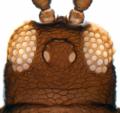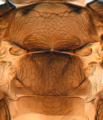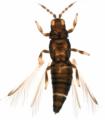Caliothrips marginipennis
Recognition data
Distinguishing features
Both sexes fully winged. Body and legs brown, tarsi yellow, also base and apex of tibiae; antennal segments III yellow, IV–V yellow at base; fore wing white with apex dark, a dark cross band following the basal third and posterior margin also dark. Antennae 8-segmented, III–IV with sensorium forked, VII–VIII elongate. Head and pronotum reticulate, with markings inside each reticle, without prominent setae. Metanotum reticulate, median setae wide apart. Metathoracic endofurca lyre-shaped and extending almost to mesothorax. Fore wing first vein with 2 setae on distal half, second vein with about 5 setae; postero-marginal cilia wavy. Tarsi 1-segmented. Abdominal tergites II–VIII with median pair of setae small, posterior margin with prominent craspedum that is toothed laterally; lateral thirds of tergites reticulate, reticles with internal markings. Sternites with 3 pairs of marginal setae arising anterior to broad craspedum.
Male sternites III–VII with slender transverse pore plate.
Related and similar species
Twenty-one species are recognized currently in the genus Caliothrips, of which 10 are known from North America (Nakahara, 1991), mostly from the southeastern States. The other species are found widely around the world in tropical and subtropical countries, with none living in Europe. C. marginipennis is one of only two species in the genus in which the forewing is extensively white.
Taxonomic data
Current valid name
Caliothrips marginipennis (Hood)
Original name and synonyms
- Heliothrips marginipennis Hood, 1912: 136
- Heliothrips bromi Moulton, 1927: 31
- Heliothrips bishoppi Moulton, 1929: 229
Family placement
Thripidae, Panchaetothripinae
Biological data
Life history
Breeding on leaves.
Host plants
Apparently associated with grasses.
Tospoviruses vectored
None
Crop damage
None
Distribution data
Area of origin
Western USA
Distribution
California, Arizona, Texas, Mexico, also Georgia.









